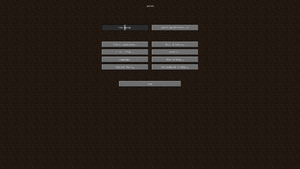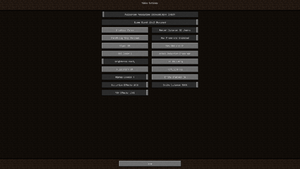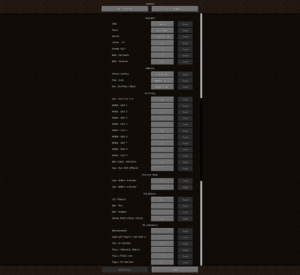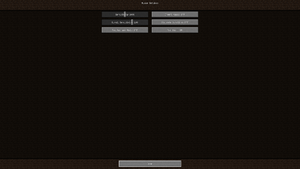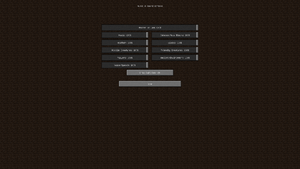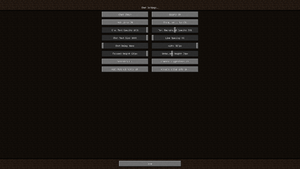Difference between revisions of "Minecraft: Java Edition"
m (→API: General maintenance with AutoWikiBrowser in Bot mode) |
|||
| Line 1,142: | Line 1,142: | ||
|linux 64-bit executable= true | |linux 64-bit executable= true | ||
|linux arm app = hackable | |linux arm app = hackable | ||
| − | |linux executable notes = PowerPC support for recent Minecraft versions require the MultiMC or Prism Launcher launchers.<ref>{{refurl|url=https://forums.raptorcs.com/index.php?topic=118.0|title=Minecraft Java Edition (LWJGL being ported)|date=2020-11-28}}</ref> ARM requires Optifine.<ref>{{refurl|url=https://www.raspberrypi.org/forums/viewtopic.php?t=270973|title= | + | |linux executable notes = PowerPC support for recent Minecraft versions require the MultiMC or Prism Launcher launchers.<ref>{{refurl|url=https://forums.raptorcs.com/index.php?topic=118.0|title=Minecraft Java Edition (LWJGL being ported)|date=2020-11-28}}</ref> ARM requires Optifine.<ref>{{refurl|url=https://www.raspberrypi.org/forums/viewtopic.php?t=270973|title=How to setup Minecraft 1.15.2 on Pi4|date=2020-11-21}}</ref> |
| − | How to setup Minecraft 1.15.2 on Pi4|date=2020-11-21}}</ref> | ||
}} | }} | ||
Revision as of 11:13, 8 December 2022
This page is for the Java Edition. For the Windows 10 version, see Minecraft: Bedrock Edition.
| Cover image missing, please upload it | |
| Developers | |
|---|---|
| Mojang | |
| Engines | |
| LWJGL | |
| Java | |
| Release dates | |
| Windows | November 18, 2011 |
| macOS (OS X) | November 18, 2011 |
| Linux | November 18, 2011 |
| Reception | |
| Metacritic | 93 |
| IGDB | 84 |
| Taxonomy | |
| Microtransactions | None |
| Modes | Singleplayer, Multiplayer |
| Perspectives | First-person |
| Genres | Survival, Open world |
| Art styles | Voxel art |
| Series | Minecraft |
| Minecraft | |
|---|---|
| Minecraft: Java Edition | 2011 |
| Minecraft: Pi Edition | 2013 |
| Minecraft: Story Mode (series) | |
| Minecraft: Education Edition | 2016 |
| Minecraft: Bedrock Edition | 2016 |
| Minecraft Dungeons | 2020 |
| Minecraft Legends | 2023 |
Minecraft, later known as Minecraft Java Edition, is a first-person survival sandbox game developed by Mojang and published by Microsoft and released on November 18, 2011 for Windows, OS X and Linux.
Key points
- Active and dedicated modding scene, responsible for many fixes, tools and additional content.
- Without mods, likely to perform worse than the Windows 10 Edition on low-end hardware.[1][2]
General information
Availability
| Source | DRM | Notes | Keys | OS |
|---|---|---|---|---|
| Official website | ||||
| Amazon.co.uk | ||||
| Microsoft Store | Included in Xbox Game Pass for PC | |||
| Amazon.com (unavailable) |
- All versions require a Microsoft account.
- Purchase includes access to Minecraft: Bedrock Edition.[3]
Free trial
- A free trial is available.
Essential improvements
Utilities
- MultiMC - a custom open source launcher. It allows to have multiple, separate instances of Minecraft, each with their own mods, texture packs, saves, etc.
- Prism Launcher - a fork of MultiMC with a built-in mod downloader and installer for Modrinth and CurseForge mods, Quilt support, better linux packaging, proper Microsoft Account support on linux, and more community-centric.
Mods
Mod Loaders
- Forge is required by most mods, and is the standard for a modded setup. Can be automatically installed with the 'Install Forge' option in MultiMC or Prism Launcher. Incompatible with Fabric.
- Fabric is required for many mods for Minecraft 1.14 and above. Can be automatically installed with the 'Install Fabric' option in MultiMC or Prism Launcher. Incompatible with Forge.
- Quilt is a hard-fork of Fabric, focusing on a faster development pace and being more community-centric. Can be automatically installed with the 'Install Quilt' option in Prism Launcher. Incompatible with Forge.
Mods
- OptiFine is a proprietary optimization mod, which also adds support for HD textures, shader packs, and graphical improvements. Compatible with Forge natively and Fabric through OptiFabric. Incompatible with Sodium.
- Performant is a proprietary general-purpose optimization mod for Forge that focuses on optimizing entities and block updates along with adding mechanisms to handle and reduce lag. Requires Forge on 1.14.4+. Incompatible with Lithium or Lithium ports, such as Roadrunner.
- The Sodium Collection is a collection of open source optimization mods that improve performance even more so than OptiFine and Performant, but only work with 1.16+. Out of the box they do not have as much functionality as OptiFine, but LambdAurora's list of OptiFine alternatives or the Fabulously Optimized modpack (inspired by that list) can be used to match or exceed OptiFine's feature-set. Requires Fabric or Quilt, incompatible with OptiFine. The main mods are:
- Sodium, for rendering engine and client-side optimizations
- Lithium, for game logic/server optimizations
- Phosphor, for lighting engine optimizations
- Hydrogen, discontinued. See FerriteCore
- FerriteCore is an open source memory usage optimization mod. The Sodium team used to make a competing mod called Hydrogen, but they now recommend this mod instead. Requires Fabric or Quilt on 1.16.5+.
- Starlight is an open source lighting engine optimization mod that claims to have much better performance than Phosphor. Incompatible with Phosphor. Requires Fabric or Quilt on 1.15.2+.
- Fabulously Optimized is a modpack that includes many of the above listed mods, such as Sodium, Lithium, FerriteCore, Starlight, and Iris (for Shader Pack support), as well as dozens of other optimization and graphics mods. It is inspired by LambdAurora's list of OptiFine alternatives, and which mods to include are now usually decided by community votes on their github page. Requires Fabric or Quilt on 1.16.5+.
Java version
- The Windows version of Minecraft includes Java (used for Minecraft only). Installing Java manually is not necessary.
- Minecraft benefits from using the latest version of Java. Using 64-bit Java on 64-bit operating systems is strongly recommended.[4]
RAM allocation
- The official launcher allows to easily allocate RAM and set other Java arguments. The manual methods are detailed below.
| OS X memory allocation[citation needed] |
|---|
|
| Linux memory allocation[citation needed] |
|---|
|
Game data
Configuration file(s) location
| System | Location |
|---|---|
| Windows | %APPDATA%\.minecraft\options.txt |
| macOS (OS X) | ~/Library/Application Support/minecraft/options.txt |
| Linux | ~/.minecraft/options.txt |
-
launcher_profiles.jsoncontains stored user profiles.
- This game does not follow the XDG Base Directory Specification on Linux.
Save game data location
| System | Location |
|---|---|
| Windows | %APPDATA%\.minecraft\saves |
| macOS (OS X) | ~/Library/Application Support/minecraft/saves |
| Linux | ~/.minecraft/saves |
- The server save is stored in
worldin the root directory of the server. - Saves are not compatible with Minecraft: Bedrock Edition.[5]
Save game cloud syncing
| System | Native | Notes |
|---|---|---|
| Xbox Cloud |
Video
| Graphics feature | State | WSGF | Notes |
|---|---|---|---|
| Widescreen resolution | |||
| Multi-monitor | Can be stretched to any window size. | ||
| Ultra-widescreen | |||
| 4K Ultra HD | |||
| Field of view (FOV) | Limited to 30-110°. Can be set to any value by editing the configuration files. See Field of view (FOV). | ||
| Windowed | Set in options or toggle with F11. | ||
| Borderless fullscreen windowed | Use Borderless Gaming with regex: Minecraft (\d+\.\d+\.\d+|\d+w\d+\w).[6]
1.13+ has native support.[7] |
||
| Anisotropic filtering (AF) | |||
| Anti-aliasing (AA) | Custom resource packs can be used when Fabulous graphics is enabled. Alternatively, use a shader pack with Fabulously Optimized (specifically, Iris), or see OptiFine. | ||
| Vertical sync (Vsync) | |||
| 60 FPS and 120+ FPS | Frame rate cap is fully configurable. | ||
| High dynamic range display (HDR) | See the glossary page for potential alternatives. | ||
| Ray tracing (RT) | Requires shader mods. | ||
| Color blind mode | Custom resource packs can be used. | ||
Field of view (FOV)
- Dynamic FOV can be disabled in Minecraft 1.16+ in Accessibility Settings.
| Set custom FOV[citation needed] |
|---|
Notes
|
Input
| Keyboard and mouse | State | Notes |
|---|---|---|
| Remapping | ||
| Mouse acceleration | Support for Raw Input was added in 1.14. Also see Mouse acceleration. | |
| Mouse sensitivity | ||
| Mouse input in menus | ||
| Mouse Y-axis inversion | ||
| Touchscreen optimised | Only usable in the inventory screen. Minecraft: Bedrock Edition has full support.[8] | |
| Controller | ||
| Controller support | Use Controllable (requires Forge) or Use Midnight Controls (requires Fabric). | |
| Full controller support | ||
| Controller remapping | ||
| Controller sensitivity | ||
| Controller Y-axis inversion |
| Controller types |
|---|
| XInput-compatible controllers |
|---|
| PlayStation controllers | Use Midnight Controls (requires Fabric). | |
|---|---|---|
| PlayStation button prompts | ||
| Light bar support | ||
| Adaptive trigger support | ||
| DualSense haptic feedback support | ||
| Connection modes | ||
| Tracked motion controllers | Use Vivecraft or Minecrift Vive. | |
|---|---|---|
| Button/gesture prompts |
| Generic/other controllers |
|---|
| Additional information | ||
|---|---|---|
| Controller hotplugging | ||
| Haptic feedback | ||
| Digital movement supported | ||
| Simultaneous controller+KB/M |
Mouse acceleration
| Disable Windows mouse acceleration[9] |
|---|
|
Audio
| Audio feature | State | Notes |
|---|---|---|
| Separate volume controls | Detailed separate volume sliders | |
| Surround sound | Up to 7.0 output.[10] | |
| Subtitles | No spoken dialog. Subtitles option actually refers to Closed Captions. | |
| Closed captions | Most sounds have their own individual captions, which are displayed as text along with the directions they come from. | |
| Mute on focus lost | Automatically pauses on focus lost, except in multiplayer. | |
| Royalty free audio |
Localizations
- Localization is done by the community via Crowdin. An up-to-date page of all supported languages can be found here
- A few joke "languages" are available as well, such as Pirate Speak, Shakespearean English, Klingon etc.
| Language | UI | Audio | Sub | Notes |
|---|---|---|---|---|
| English | Includes localizations for Australia, Canada, UK, USA and New Zealand | |||
| Afrikaans | ||||
| Albanian | ||||
| Arabic | ||||
| Armenian | ||||
| Asturian | ||||
| Azerbaijani | ||||
| Bashkir | ||||
| Basque | ||||
| Belarusian | ||||
| Bosnian | ||||
| Breton | ||||
| Bulgarian | ||||
| Catalan | Available in variants: Catalan and Valencian | |||
| Simplified Chinese | ||||
| Traditional Chinese | ||||
| Cornish | ||||
| Croatian | ||||
| Czech | ||||
| Danish | ||||
| Dutch | Includes localizations for Netherlands, Belgium, and Brabant, as well as Limburgish | |||
| Esperanto | ||||
| Estonian | ||||
| Faroese | ||||
| Filipino | ||||
| Finnish | ||||
| French | Regular French and Occitan | |||
| Canadian French | ||||
| Frisian | ||||
| Galician | ||||
| Georgian | ||||
| German | Includes localizations for Austria, Germany, Switzerland, Bavaria, Upper Saxon, Franconia, and northern Germany (Low German) | |||
| Greek | ||||
| Hawaiian | ||||
| Hebrew | ||||
| Hindi | ||||
| Hungarian | ||||
| Icelandic | ||||
| Ido | ||||
| Igbo | ||||
| Indonesian | ||||
| Interslavic | In the Latin alphabet | |||
| Irish | ||||
| Italian | Available in variants: Italian, Lombardian, Friulian, and Venetian | |||
| Japanese | ||||
| Kannada | ||||
| Kazakh | ||||
| Korean | ||||
| Kurdish | ||||
| Latin | ||||
| Latvian | ||||
| Lithuanian | ||||
| Luxembourgish | ||||
| Macedonian | ||||
| Malay | ||||
| Maltese | ||||
| Mongolian | ||||
| Nahuatl | ||||
| Nepali | ||||
| Northern Sami | ||||
| Norwegian | Available in variants: Non-descript (i.e. Bokmål) and Nynorsk | |||
| Persian | ||||
| Polish | ||||
| Portuguese | ||||
| Brazilian Portuguese | ||||
| Ripuarian | ||||
| Romanian | ||||
| Russian | Available in modern and pre-revolutionary orthography | |||
| Scottish Gaelic | ||||
| Serbian | Cyrillic orthography | |||
| Slovak | ||||
| Slovenian | ||||
| Somali | ||||
| Spanish | Regular Spanish and Andalusian | |||
| Latin American Spanish | Includes localizations for Argentina, Chile, Mexico, Uruguay, Venezuela, and Ecuador | |||
| Polish | Regular Polish and Silesian | |||
| Swedish | Regular Swedish and Elfdalian | |||
| Tagalog | ||||
| Tamil | ||||
| Tatar | ||||
| Thai | ||||
| Turkish | ||||
| Ukrainian | Regular Ukrainian and Rusyn | |||
| Valencian | ||||
| Vietnamese | ||||
| Welsh | ||||
| Yiddish | ||||
| Yoruba |
Network
- Requires a Microsoft account.
- Multiplayer is not compatible with Minecraft: Bedrock Edition unless Geyser is used.[8]
Multiplayer types
| Type | Native | Players | Notes | |
|---|---|---|---|---|
| Local play | 2147483647 | Usable with the Joypad mod. Max players is capped to the max integer size in Java.[11] |
||
| LAN play | 8 | Maximum 8 players | ||
| Online play | 2147483647 | Max players is capped to the max integer size in Java.[11] | ||
Connection types
| Type | Native | Notes |
|---|---|---|
| Matchmaking | ||
| Peer-to-peer | ||
| Dedicated | ||
| Self-hosting | ||
| Direct IP |
Ports
| Protocol | Port(s) and/or port range(s) |
|---|---|
| TCP | 25565 |
- Universal Plug and Play (UPnP) support status is unknown.
VR support
| 3D modes | State | Notes | |
|---|---|---|---|
| Native 3D | 3D Anaglyph support removed in 1.13 and above. | ||
| Nvidia 3D Vision | See Helix Mod: Minecraft 1.7.10 in 3D Vision. | ||
| Headsets | |||
|---|---|---|---|
| SteamVR | Use Vivecraft or Minecrift Vive. | ||
| Oculus VR (LibOVR) | Can also use Vivecraft or Minecrift. | ||
| Windows Mixed Reality | Use Vivecraft or Minecrift Vive. | ||
| OSVR | |||
| Devices | |||
|---|---|---|---|
| Tracked motion controllers | Use Vivecraft or Minecrift Vive. See Input for details. |
||
| Traditional controller | See Input for details. | ||
| Keyboard/Mouse | |||
| Play area | |||
|---|---|---|---|
| Seated | |||
| Standing | |||
| Room-scale | Use Vivecraft or Minecrift Vive. | ||
Steam Deck
Minecraft is not available through SteamOS, but can be installed manually. Minecraft can be played through a launcher such as Prism Launcher (a fork of MultiMC).
| Install Minecraft using Prism Launcher[12] |
|---|
|
Issues fixed
- Mojang has created an Official Bug Tracker that can be used to find or report bugs.
Graphical issues
| Black borders on Blocks[1] |
|---|
|
Other information
API
| Technical specs | Supported | Notes |
|---|---|---|
| OpenGL | 3.2, 4.4, 4.5 | |
| Vulkan | Undocumented officially. Use VulkanMod with the Fabric or Quilt mod loaders to enable it. Incompatible with Sodium or any other mod that relies on OpenGL rendering. |
| Executable | PPC | 32-bit | 64-bit | ARM | Notes |
|---|---|---|---|---|---|
| Windows | |||||
| macOS (OS X) | PowerPC is only known to support up to 1.5.2, due to Java ≥6 not having PowerPC versions.[13] ARM requires m1-multimc-hack and the MultiMC or Prism Launcher launchers. | ||||
| Linux | PowerPC support for recent Minecraft versions require the MultiMC or Prism Launcher launchers.[14] ARM requires Optifine.[15] |
System requirements
| Windows | ||
|---|---|---|
| Minimum[16] | Recommended | |
| Operating system (OS) | 7 | 10, 11 |
| Processor (CPU) | Intel Core i3-3210 3.2 GHz AMD A8-7600 3.1 GHz |
Intel Core i5-4690 3.5 GHz AMD A10-7800 3.5 GHz |
| System memory (RAM) | 2 GB | 4 GB |
| Hard disk drive (HDD) | 1 GB | 4 GB |
| Video card (GPU) | Nvidia GeForce 400 series AMD Radeon HD 7000 series Intel HD Graphics 4000 AMD Radeon R5 series OpenGL 4.4 compatible Shader model 5.0 support |
Nvidia GeForce 700 series AMD Radeon Rx 200 series OpenGL 4.5 compatible |
| macOS (OS X) | ||
|---|---|---|
| Minimum[16] | Recommended | |
| Operating system (OS) | 10.14.5 (Mojave) | |
| Processor (CPU) | Intel Core i3-3210 3.2 GHz AMD A8-7600 3.1 GHz |
Intel Core i5-4690 3.5 GHz AMD A10-7800 3.5 GHz |
| System memory (RAM) | 2 GB | 4 GB |
| Hard disk drive (HDD) | 1 GB | 4 GB |
| Video card (GPU) | Nvidia GeForce 400 series AMD Radeon HD 7000 series Intel HD Graphics 4000 AMD Radeon R5 series OpenGL 4.4 compatible Shader model 5.0 support |
Nvidia GeForce 700 series AMD Radeon Rx 200 series OpenGL 4.5 compatible |
- PowerPC support was retired with version 1.6.
| Linux | ||
|---|---|---|
| Minimum | Recommended | |
| Operating system (OS) | 3.0 | 5.0+ |
| Processor (CPU) | Intel Core i3-3210 3.2 GHz AMD A8-7600 3.1 GHz |
Intel Core i5-4690 3.5 GHz AMD A10-7800 3.5 GHz |
| System memory (RAM) | 2 GB | 4 GB |
| Hard disk drive (HDD) | 1 GB | 4 GB |
| Video card (GPU) | Nvidia GeForce 400 series AMD Radeon HD 7000 series Intel HD Graphics 4000 AMD Radeon R5 series OpenGL 4.4 compatible Shader model 5.0 support |
Nvidia GeForce 700 series AMD Radeon Rx 200 series OpenGL 4.5 compatible |
| Other | Any modern distro | Up to date version of OpenJDK or Oracle Java |
References
- ↑ Minecraft: Java Edition vs Windows 10 | PC Gamer
- ↑ Minecraft Java Edition and Bedrock Edition are coming to Xbox Game Pass for PC - last accessed on 2021-10-17
- "Java Edition is also much more demanding on your hardware, which is why you might want to check out Bedrock Edition, which is the multiplatform, cross-play, and gamepad compatible version of the game."
- ↑ | Minecraft: Java & Bedrock Edition FAQ
- ↑ http://www.minecraftforum.net/topic/269042-java-7-massive-minecraft-performance-boost/
- ↑ Minecraft: Windows 10 Edition Beta - Microsoft Store
- ↑ Post your feature request here :: Borderless Gaming General Discussions
- ↑ New borderless fullscreen feature is not borderless fullscreen - last accessed on 2020-04-26
- "Possible issues"
- ↑ 8.0 8.1 Announcing: Minecraft: Windows 10 Edition Beta
- ↑ http://donewmouseaccel.blogspot.com/2010/03/markc-windows-7-mouse-acceleration-fix.html
- ↑ PC Gaming Surround Sound Round-up
- ↑ 11.0 11.1 Arqade - What is the maximum number of players on a Minecraft/Bukkit server? - last accessed on 2019-03-02
- ↑ Minecraft Guide for the Steam Deck - YouTube - last accessed on 2022-03-15
- ↑ Minecraft 1.2.5 and 1.5.2 for PowerPC - last accessed on 2020-11-28
- ↑ Minecraft Java Edition (LWJGL being ported) - last accessed on 2020-11-28
- ↑ How to setup Minecraft 1.15.2 on Pi4 - last accessed on 2020-11-21
- ↑ 16.0 16.1 Minecraft Help Center - Minecraft: Java Edition Installation Issues FAQ

